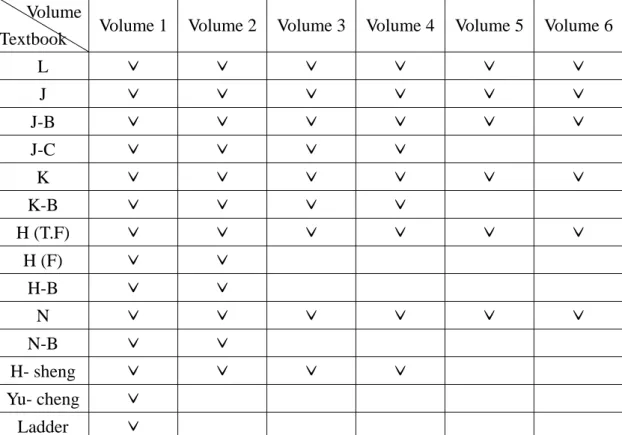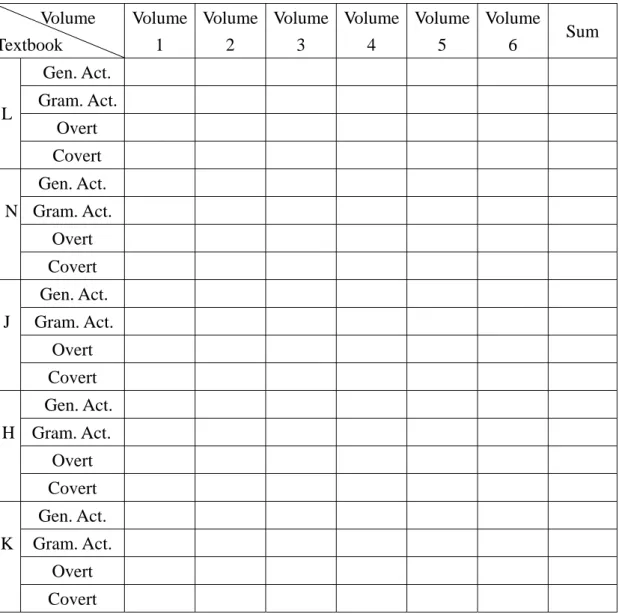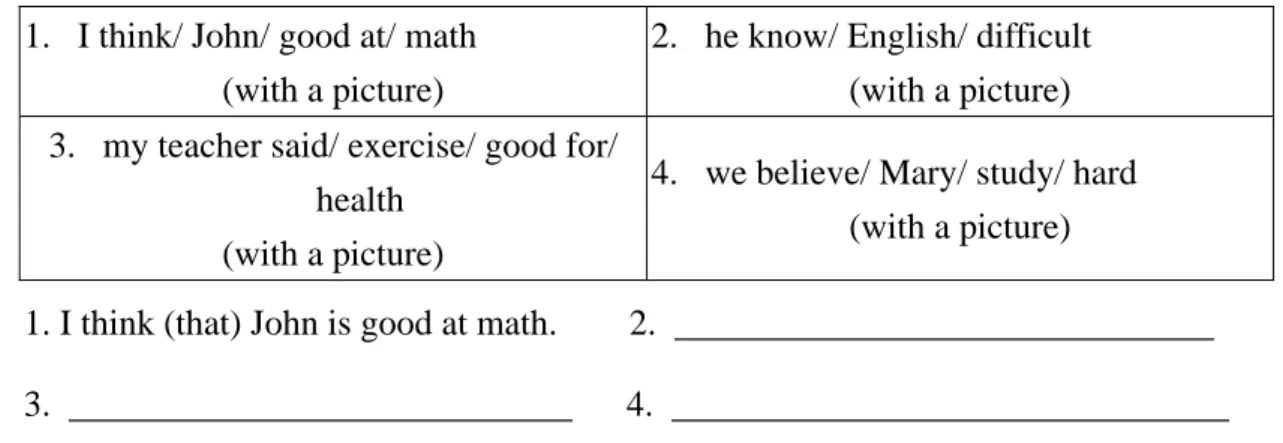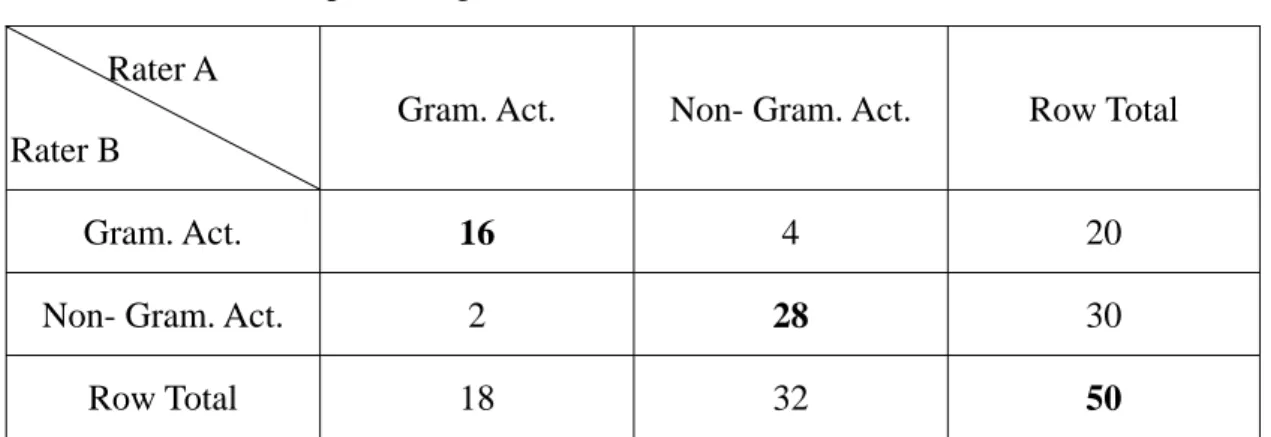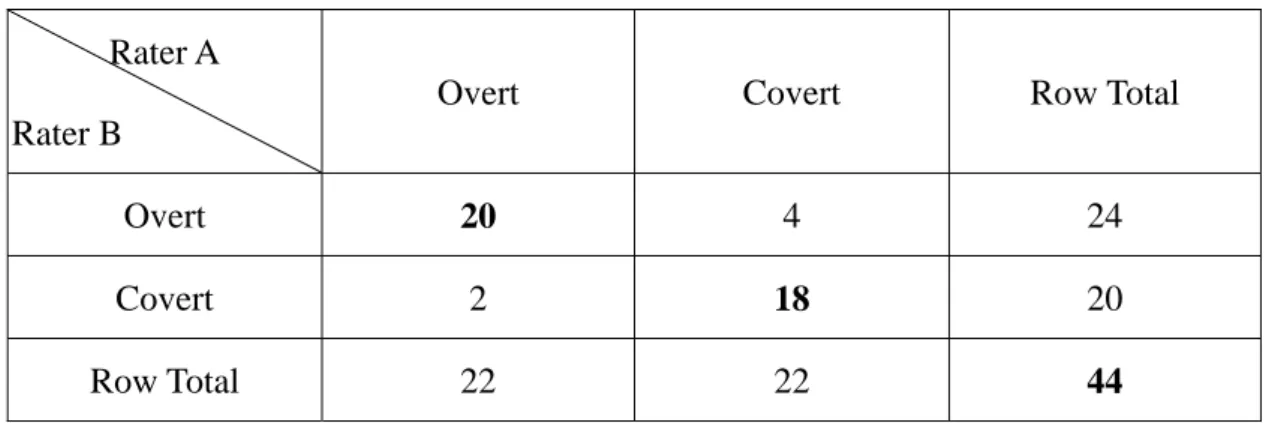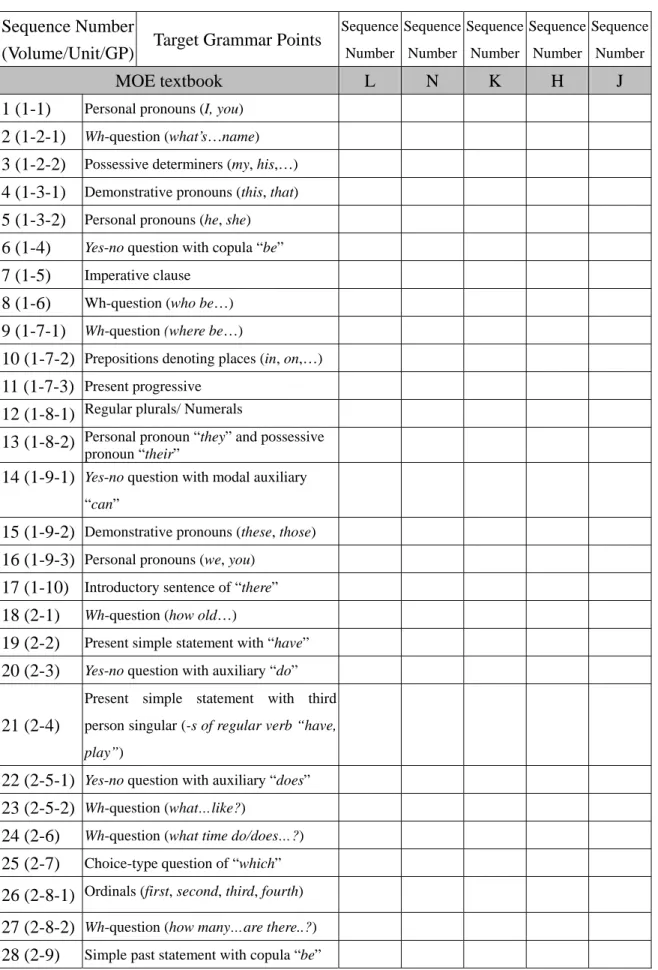Chapter Three Research Method
The present study aims to investigate the grammatical instruction in the current junior high English textbooks. Grammar activities in five sets of junior high English textbooks (L, N, J, H, K) are examined with respect to their proportion, presentation, and communicativeness. Furthermore, the grammar sequencing and coverage are evaluated here with reference to the ones in the MOE textbook.
The Raters
To achieve objectiveness, four raters are involved in the process of rating. These raters include the researcher herself and her three colleagues. Each of these teachers has more than five years of teaching experience. Meanwhile, these three teachers are members of the Compulsory Education Advisory Group of Hsinchu Municipal Department of Education. They spend much time doing action research, holding seminars for teachers in Hsinchu, and helping teachers from other junior high schools in Hsinchu to know more about teaching principles in NIC. One of them is also a seed teacher for the nine-year elementary education program hosted by the MOE.
Target Textbooks for Evaluation
At the time of the present study, there were altogether fourteen sets of textbooks
approved by NICT and issued in the market. Table 2 shows the detailed information.
Considering the integrity of research, the researcher needed to examine a whole set of six volumes. Therefore there were six complete sets: L, J, J-B, K, N, and H (T.F.).
Among them, J-B is rarely used in schools now because it will be discontinued soon.
Thus J-B textbook is not examined in the present study. Hence the target textbook series in the present study are as follows: (a) The standard version of L English
textbooks; (b) The standard version of N English textbooks; (c) The standard version of J English textbooks; (d) The standard version of H (T.F.) English textbooks, and (e) The standard version of K English textbooks.
Table 1 Approved Standard Versions of Junior High English Textbooks Volume
Textbook Volume 1 Volume 2 Volume 3 Volume 4 Volume 5 Volume 6
L ˇ ˇ ˇ ˇ ˇ ˇ
J ˇ ˇ ˇ ˇ ˇ ˇ
J-B ˇ ˇ ˇ ˇ ˇ ˇ
J-C ˇ ˇ ˇ ˇ
K ˇ ˇ ˇ ˇ ˇ ˇ
K-B ˇ ˇ ˇ ˇ
H (T.F) ˇ ˇ ˇ ˇ ˇ ˇ
H (F) ˇ ˇ
H-B ˇ ˇ
N ˇ ˇ ˇ ˇ ˇ ˇ
N-B ˇ ˇ
H- sheng ˇ ˇ ˇ ˇ
Yu- cheng ˇ
Ladder ˇ
Note. The table is based on the information from the list of approved textbooks shown on the NICT website
In order to get a clear picture of the development of textbook design, the researcher also collected the last MOE textbooks compiled by the NICT. This set of textbooks provides a comparative framework in this study.
The standard versions are the final and complete versions of the textbooks.
Before the standard versions, there were tentative ones. The tentative versions are for sixth graders who enrolled in the first year of the Nine-year Integrated Curriculum, namely, in 2001; those who enrolled in (and after) 2003 use the standard versions. The standard versions are more complete because they are revised according to the opinions given on the tentative versions by the NICT. That is to say, the standard
versions are the final versions and hence will not easily be changed or revised.
Therefore, their content can have greater influence on students’ learning than the tentative ones, and should be carefully examined. The researcher collects all the five textbook series of junior high schools and examines their grammar activities. The total numbers of their activities are counted and presented in the following table. The definition of activity is based on the consensus made by the raters during their first meeting.
During the first discussion, the raters found that each set of textbooks had its own titling system. That is, one activity in Textbook A may be two separate activities in Textbook B. After discussion, the raters agreed that the major principle for identifying an activity is by the title. Those subtitles under one main title can be identified as different activities if they have no connection with the main title. After the total number of activities is confirmed, grammar activities are selected from these activities by the raters.
Workbooks in these textbook series are not included in the research for the following reasons:
1. In respect of grammar coverage and sequence, there are no new target grammatical items in the workbooks. In other words, results of grammar coverage and sequence in textbook are supposed to be the same as those in the workbooks. Therefore, it’s not necessary to examine these workbooks.
2. As for the proportion of grammar activity (Gram. Act.), the researcher conducted a pilot study on them in both workbooks and textbooks. She used Volume One of the textbooks and workbooks in each set as samples for the pilot study. Table 3 showed the results of Gram. Act. Proportions both in the textbooks and workbooks. There was no significant difference found in the results. Therefore the workbooks are not examined in the present study.
Table 2 Results of Pilot Study on Grammar Activity Proportion
Workbook (Volume 1) Textbook (Volume 1) Gram. Act./
Gen. Act. Percentage Gram. Act./
Gen. Act. Percentage
L 21/66 40.9% 68/160 42.5%
N 40/102 39.22% 67/162 41.36%
J 35/82 42.68% 44/95 46.32%
H 48/70 68.57% 86/121 71.07%
K 20/60 33.34% 57/159 35.85%
Note. Gram. Act. = Grammar Activity Gen. Act. = General Activity
Definition of Grammar Activity
One purpose of this study is to investigate the proportion of grammar activity in each set of textbook. Among the total activities, the researcher further selects grammar activities for evaluating. The criteria for the identification of a grammar activity are described below.
Title of activity
First of all, the researcher examined each individual activity to see if the title of activity displays its purpose for grammar practicing. For example, “ Language Focus”
in the L textbook, “Grammar Focus” in the K textbook, “Sentence Patterns” in the N textbook, and “structure” in the H textbook. The title of the activity that explicitly conveyed the concept of grammar practice was classified as a grammar activity.
Repetitiveness and focus on grammar
Some grammar activities were not easy to tell from the titles. In this case, the researcher further checked the contents of these activities. The criterion here was to
check if the content focused on grammar practice and kept practicing a certain grammar point repeatedly. The activity content that met this requirement was classified as a grammar activity. Here “repetition” and “focus” on one specific grammatical form were crucial features for identifying grammar activities.
Specification in teacher’s manual
Furthermore, the researcher referred to the teacher’s manual of each textbook to identify whether one activity was designed mainly for grammar practice. For those activities whose purposes were not mainly for grammar practice, they were not included in calculation. According to this criterion, the reading text and dialogue were not included since these two kinds of activities were not designed mainly for grammar practice.
Discussion and consensus among raters
The researcher also consulted and discussed with her three colleagues. Based on their experience, they judged whether one activity was a grammar activity. In this part of examination, the researcher first held a meeting with these teachers. In the meeting, they first built up a consensus towards the definition of a grammar activity and then randomly chose some activities and went through them. They brainstormed some ideas about the principle of identifying grammar activities and achieved an agreement about the three criteria mentioned above. Then they talked more about those activities they had divergent ideas about. For example, Rater A thought that the grammar table and the following practice should be treated as a whole activity because they shared the same and consistent concept. Rater B thought they should be counted as two separate activities since they had different subtitles within one main title and could be practiced individually during the teaching process. After discussion, the raters agreed
that they should be treated as one activity. Another diversity is the warm-up activity.
Two raters thought the warm-up activity could not be a grammar activity at all. But the other raters thought it should depend on the arrangement of the photos and hints.
If they were explicitly arranged for guiding teachers to use target grammatical forms repeatedly, the activity was a grammar activity. After discussion, the raters agreed to check the content of warm-ups and examine them in teacher’s manual to see if they strongly assisted to grammar teaching.
After the first meeting, the researcher made a checklist (Appendix A) for each teacher to review some lessons randomly sampled from each set of textbook. She sampled one book from each set and two lessons form each book. That is, there were totally ten lessons for each rater to do the sample check. After they conducted the sample rating separately, later in the second meeting, they discussed the results from their checklist. They thoroughly discussed the diversities of their checklists. After these two meetings, they built up consensus on rating criteria and principles.
Data Analysis
Calculation for proportion and explicitness of target grammar activity
Based on the criteria elucidated above, the examination was done by four raters.
The raters distinguished general activities from grammar activities and their total numbers were recorded in Table 4. Regarding the grammar activities, the raters further divided them into overtly and covertly presented ones. These two terms here indicating presentation of grammatical rules in activities originate from the concept offered by Harmer (1986). The concept is similar to the distinction of explicit and implicit grammar teaching illustrated in Chapter 2. Here the researcher uses Harmer’s (1986) terms, namely, “overt” and “covert” to identify the explicitness of grammar
activities. As mentioned in Chapter 2, the former refers to grammar activities that give explicit grammar explanation, examples, or hints toward target grammatical rules. The latter refers to grammar activities that give no grammatical illustration. In other words, grammatical items are not introduced in this kind of activity but hidden in it. Below is a chart for the raters to finish during the process of formal examination.
Table 3 Numbers of General Activities and Grammar Activities and Their Ways of Presentation in Target Textbooks
Volume Textbook
Volume 1
Volume 2
Volume 3
Volume 4
Volume 5
Volume
6 Sum
Gen. Act.
Gram. Act.
Overt L
Covert
Gen. Act.
Gram. Act.
Overt N
Covert
Gen. Act.
Gram. Act.
Overt J
Covert
Gen. Act.
Gram. Act.
Overt H
Covert
Gen. Act.
Gram. Act.
Overt K
Covert
According to Table 4, the calculation for the proportion of grammar activity in
each textbook is as follows:
1. Proportion of grammar activity
= number of total grammar activity ÷ number of total general activity
2. Proportion of overt grammar activity
= number of overt grammar activity ÷ number of total grammar activity 3. Proportion of covert grammar activity
= number of covert grammar activity ÷ number of total grammar activity Calculation for communicativeness of target grammar activity
Furthermore, the researcher also used the criteria proposed by Paulston and Bruder (1976) to calculate the communicativeness of grammar activities. Paulston and Bruder proposed three categories to refer to structural pattern practice: mechanical, meaningful, and communicative. The researcher adopted these three categories to examine the distribution of these three kinds of grammar activities in target textbooks.
Mechanical grammar activity
According to Paulston and Bruder (1976), mechanical grammar activities are defined as drills where there is complete control of response, and where there is only one correct way of responding with a focus on the correct form of sentence structures or grammar points. The activities have no connection with the real world or the truth.
They are neither authentic nor variable.
Grammar Focus I
You He She
We They
talked to Ted listened to music
before after
I you
he she we they
did exercise.
cooked dinner.
Make Sentences
Example Linda / drank milk / went to bed→Linda drank milk before she went to bed.
(From Lesson 5, Volume 3, K)
In this activity, the practice on the combination of sentence elements aims to practice the correct arrangement of the sentence on the basis of correct sentence structure. It is a kind of mechanical activity. Students can do the practice without knowing the meaning of the whole sentence. They can just count on their knowledge of the target form.
Meaningful grammar activity
In a meaningful drill there is still control of response, but it allows more response than mechanical drill does (Paulston and Bruder, 1976). Thus meaningful grammar activities involve interaction or response. They are often presented in dialogues within a fixed pattern. They have some degree of connection with reality. In spite of a meaningful context, this type of grammar activity allows limited answers. Hence they are more like a trial-and-error process involved in finding the correct response.
Speaking Practice: Look at the pictures and make sentences.
Example (with a picture) ghost story/ was scary
→ The ghost story was scary, wasn’t it? Yes, it was.
1. (with a picture) Lily and Mary/ are talking on the phone
→ 2. (with a picture) sings/ fell down last week
→ 3. (with a picture) Ted/ do the dishes every day
→ 4. (with a picture) typhoon/ is coming from the south
→
(From Lesson 3, Volume 5, H) This activity does not offer a fixed answer for the student to fill in the blanks.
Students can fill in the blank with some meaningful words according to what they learn from the target sentence pattern. They have to complete the sentences on the basis of the target form, and also answer the questions they make with the help of the messages offered in the pictures. But the response and answer here are still controlled and predictable for the teacher.
Communicative grammar activity
This type of grammar practice provides students with open and free responses or answers. It also gives students opportunities for negotiation about meaning within a focused form or sentence structure. This type of grammar practice is contextual and authentic. Compared to meaningful ones, they don’t expect certain correct answers;
they allow free and open responses.
Look and write. Ask your friends.
you your friends
1. How many years have you lived in Taipei (Taichung, Tainan)?
2. How many years have you been a student at your school?
(From Lesson 1, Volume 5, L) This activity provides a pattern practice of the present perfect tense. It leaves an open-ended question here for students to answer variably. Students can not only practice the target pattern but also achieve communication interpersonally.
Furthermore, the answers can be various. There is no so-called correct answer here.
The correctness totally depends on conforming to the real situation of students and their friends.
When the raters were examining this part, there were some divergent opinions.
Negotiation was made in the process of discussion to achieve consensus. In the second meeting, the raters discussed the results on their checklist activity by activity.
In the communicativeness part of grammar activities, there were still some divergences. These examples of initial divergence are described as follows:
Example 1: “Listen and Repeat”
1.Teresa Teng (with a picture) 2. Tiger Woods (with a picture) 3. J.K. Rowling (with a picture) 4. Mark Twain (with a picture) 5. Confucius (with a picture) 6.
Abraham Lincoln (with a picture) 7. Marie Curie (with a picture) 8. Albert Einstein (with a picture) 9. Yo-yo Ma (with a picture) 10. Helen Keller (with a picture) 11. Ang Lee (with a picture) 12. Jane Goodall (with a picture)
Say it A: What’ his/ her name? B: His/ her name is .
(From Lesson1, Volume 1, K) Raters A and B thought it was a mechanical activity because the pattern was offered and the answer was fixed. The only job for students was to fill the name in the blank. This was a kind of substitution. It was obviously mechanical. While Raters C and D argued that the pictures and names were adopted from the real world. The content here was meaningful and authentic. Teachers here can guide students to talk more about those people, and the whole teaching situation could be meaningful.
Raters A and B further pointed out that although the presentation of this activity might be meaningful, the title “listen and repeat” displayed the purpose of practice was to follow the given sentence pattern and repeat it without fully understanding the context.
Most teachers would have their students just do the substitution and practice the sentence pattern repeatedly. After discussion, Raters A and B admitted those photos relating to the real world were meaningful to learners. In the end, the raters all agreed to classify it into the category of meaningful activity.
Example 2: “Make sentences”
1. I think/ John/ good at/ math (with a picture)
2. he know/ English/ difficult (with a picture) 3. my teacher said/ exercise/ good for/
health (with a picture)
4. we believe/ Mary/ study/ hard (with a picture)
1. I think (that) John is good at math. 2.
3. 4.
(From Lesson2, Volume 4, N) Raters A and B thought it was obviously mechanical since the words were offered and the word order was fixed. There was also an example to explicitly show how to make a sentence. The only job for students was to link these words in the fixed order to make a grammatical sentence. But Raters C and D thought the pictures were authentic and meaningful, and students could add some words at the end of the sentence to make the sentence longer in order to describe the picture more. It could be meaningful this way. After discussion, the raters agreed that this kind of activity should be treated as meaningful activity. Following the criteria mentioned previously, results of the examination were recorded in Table 5.
Table 4 Classifications of Grammar Activities: Mechanical, Meaningful, and Communicative
Volume
Textbook Volume 1 Volume 2 Volume 3 Volume 4 Volume 5 Volume 6 Sum
Mechanical
Meaningful
L
Communicative
Mechanical
Meaningful
N
Communicative
Mechanical
Meaningful
J
Communicative
Mechanical
Meaningful
H
Communicative
Mechanical
Meaningful
K
Communicative
When calculating the proportion of communicativeness, the researcher examined
activities according to these three categories. Then the calculation is done like this:
1. Proportion of mechanical grammar activity
= number of mechanical grammar activity÷number of total grammar activity
2. Proportion of meaningful grammar activity
= number of meaningful grammar activity÷number of total grammar activity
3. Proportion of communicative grammar activity
= number of communicative grammar activity÷number of total grammar activity
Inter-rater Reliability
In order to achieve the objectiveness of the results, as mentioned previously, the raters included the researcher herself and her three colleagues. In Chapter Three, the consensus-making process was clearly described. The formal rating was done by the researcher herself and one of the other raters, who has graduated from the Education Graduate Institution of NTNU and is also a seed teacher in the researcher’s school. As for the other two raters, they served as consultants to offer referential opinions for the raters when they did their formal rating separately. After the two raters finished their rating from Volumes 1 to 2 of each textbook, inter-rater reliability was checked to see
the consistency between the rating results of the two raters. The consistency achieved a reliable level, and the rest of rating was done by the researcher herself.
The measurement of inter-rater reliability is based on Hsu’s (2001) study. The method of measuring is straightforward and aims to check whether complete agreement is achieved between the two raters. After the raters independently classifying the grammar activities, the times a certain grammar activity is classified as exactly the same type by the raters are listed. For example, if Rater A and Rater B independently recognize 44 grammar activities from 50 total general activities, a few steps are taken to measure the consistency:
1. First calculate the inter-reliability on grammar activity classification. (Table 6) 2. Further recognize the grammar activities that are classified to the same types
(overt/ covert; mechanical/ meaningful/communicative) by the two raters.
3. Count these exact-matched items.
4. Divide the result of 3 by the total number of grammar activity recognized.
In the example of 44 grammar activities analyzed from 50 general activities, the classification results are listed in Tables 6, 7, and 8 to show the numbers of exact-matched items which are bold-faced.
Table 5 The Example for Agreements on Classifications of Grammar Activities Rater A
Rater B
Gram. Act. Non- Gram. Act. Row Total
Gram. Act. 16 4 20
Non- Gram. Act. 2 28 30
Row Total 18 32 50
According to Table 6, the inter-rater reliability of Gram. Act. classification between Raters A and B is: (16 + 28) ÷ 50 = 88%.
Table 6 The Example for Agreements on Classifications of Explicitness Rater A
Rater B
Overt Covert Row Total
Overt 20 4 24
Covert 2 18 20
Row Total 22 22 44
According to Table 7, the inter-rater reliability of explicitness classification between Raters A and B is: (20 + 18) ÷ 44 = 86.36%.
Table 7 The Example for Agreements on Classifications of Communicativeness Rater A
Rater B
Mechanical Meaningful Communicative Row Total
Mechanical 10 1 0 11
Meaningful 4 23 0 27
Communicative 0 0 6 6
Row Total 14 24 6 44
According to Table 8, the inter-rater reliability of classification for communicativeness between Raters A and B is: (10 + 23 + 6) ÷ 44 = 88.64%.
The two raters conducted the rating of Volumes 1 and 2 in these five textbooks separately. The results and inter-rater reliability were shown and calculated in Chapter Four. According to Hsu (2001), the inter-rater reliability over 90% can be accepted as a reliable level.
Sequencing of Grammatical Items
The MOE textbook compiled in 1997 is the first set of textbooks using the principles of CLT for compilation. It is possible for private publishers to use the
syllabus or skeleton of the MOE textbook as a reference for their textbook compilation. For example, on the website of the J textbook, the publisher responded to complaints about grammar content from teachers by revising part of the syllabus with reference to the MOE textbook. The L publisher even made a list to compare grammar sequence in the MOE and the L textbook. The referential value of the MOE textbook for private publishers is the first reason why the researcher adopts the MOE textbooks as a baseline for the comparison of grammar sequencing in the present study.
The second reason is that most teachers are accustomed to using the MOE textbook. In an informal interview with 20 English teachers in junior high school, 17 of them thought the MOE textbook has a better framework of grammar instruction.
The sequence of grammar points is clearer and easier to understand for students.
When they came across some difficult grammar points in private textbooks, they referred back to the MOE textbook and copied grammar activities in it for students to practice. Most of these teachers pointed out that when they were preparing for a new lesson, they usually thought of content in the MOE textbook. One of the teachers said,
“It’s natural for me to recall the counterparts in the MOE textbook and how they are taught in it”. In Su’s (2003) study, 70% of the teachers he interviewed thought very positively of content in the MOE textbook. It shows that the MOE textbook is still highly valued by most teachers. This is the second reason why the researcher uses the MOE textbook as a base for comparison.
The researcher is curious about how similar the grammar syllabus of the MOE textbook and private textbooks would be. The coverage and sequencing of grammar points in the MOE textbook can provide a baseline for textbook comparison to see the similarities and differences among these five sets. Below is a chart for comparison to be finished in the process of textbook examination.
Table 8 Comparison for Grammar Sequencing between MOE and Target textbooks
Sequence Number
(Volume/Unit/GP) Target Grammar Points Sequence
Number
Sequence Number
Sequence Number
Sequence Number
Sequence Number
MOE textbook L N K H J
1 (1-1) Personal pronouns (I, you)
2 (1-2-1) Wh-question (what’s…name)
3 (1-2-2) Possessive determiners (my, his,…)
4 (1-3-1) Demonstrative pronouns (this, that)
5 (1-3-2) Personal pronouns (he, she)
6 (1-4) Yes-no question with copula “be”
7 (1-5) Imperative clause
8 (1-6) Wh-question (who be…)
9 (1-7-1) Wh-question (where be…)
10 (1-7-2) Prepositions denoting places (in, on,…)
11 (1-7-3) Present progressive
12 (1-8-1) Regular plurals/ Numerals
13 (1-8-2) Personal pronoun “they” and possessive pronoun “their”
14 (1-9-1) Yes-no question with modal auxiliary
“can”
15 (1-9-2) Demonstrative pronouns (these, those)
16 (1-9-3) Personal pronouns (we, you)
17 (1-10) Introductory sentence of “there”
18 (2-1) Wh-question (how old…)
19 (2-2) Present simple statement with “have”
20 (2-3) Yes-no question with auxiliary “do”
21 (2-4)
Present simple statement with third person singular (-s of regular verb “have, play”)
22 (2-5-1) Yes-no question with auxiliary “does”
23 (2-5-2) Wh-question (what…like?)
24 (2-6) Wh-question (what time do/does…?)
25 (2-7) Choice-type question of “which”
26 (2-8-1) Ordinals (first, second, third, fourth)
27 (2-8-2) Wh-question (how many…are there..?)
28 (2-9) Simple past statement with copula “be”
29 (2-10) Past simple negation and yes/no question with copula “be”
30 (3-1) Past simple statement with irregular verb
“have, go”
31 (3-2-1) Formation of past simple verbs (irregular/
regular)
32 (3-2-2) Yes-no question with auxiliary “did”
33 (3-3) Coordinating conjunctions (and/but/so)
34 (3-4-1) Wh-question (How much is…)
35 (3-4-2) Quantifiers “many, much, some, any”
36 (3-5) Prepositions denoting places (next to, in, in front of, between,…)
37 (3-6-1) Objective case of pronouns
38 (3-6-2) Transitive verb (give/buy)
39 (3-7) Prepositions denoting time (in, on, at,…)
40 (3-8-1) Yes-no question with future auxiliary (will…)
41 (3-8-2) Yes-no question with future auxiliary (be going to…)
42 (3-9-1) Time adverbs (always, usually,…)
43 (3-9-2) …every day, once a week, twice…
44 (3-10) Mental verb (Like/enjoy/hate + V-ing)
45 (4-1-1) Ing-clause as subject of a sentence
46 (4-1-2) Semi-modal “have to”
47 (4-2) To-infinitive clause as object of a sentence (…V to V)
48 (4-3) Ing-clause as object of a preposition
49 (4-4) Adverbial subordinators denoting time
50 (4-5) Basic pattern of comparative sentences
51 (4-6) Adverbs
52 (4-7-1) Substitute pronoun “one”
53 (4-7-2) Basic pattern of superlative sentences
54 (4-8-1) Correlative coordinator (Not only…but also…)
55 (4-8-2) (one/both/some/most/all,…) + of…
56 (4-9-1) Possessive pronoun/ nouns (mine, yours, John’s, …)
57 (4-9-2) Copula verb (become/get/look)
(4-10) Review
58 (5-1-1) Present perfect
59 (5-1-2) Reflexive pronoun
60 (5-2-1) Tag question
61 (5-2-2) Adverbial clause (if…)
62 (5-3-1) Passive voice I
63 (5-3-2) Adverbial clause (when…)
64 (5-4-1) Passive voice II
65 (5-4-2) Prepositional phrase as post-modifier
66 (5-5-1) Relative clause I (objective case)
67 (5-5-2) Relative clause II (subjective case)
68 (5-6) It takes (time) to V
69 (5-7-1) It is + adjectives + to V
70 (5-7-2) Past participle as adjective
71 (5-8-1) Causative verb (let, make, have)+ V
72 (5-8-2) Modal auxiliary “should”
73 (5-9-1) that clause
74 (5-9-2) used to +V
75(5-10-1) too … to …
76(5-10-2) Wh- clause
77(5-10-3) Usage of “either”
78(5-11-1) So … that …
79(5-11-2) Wh- phrase
Note. The denotation of grammatical items used in this table is adopted from the book “Longman Grammar of Spoken and Written English”. The reason it is adopted is that it collects descriptive grammar about not only written text but also spoken data.
The numbers in Table 9 refer to the sequence number of each grammar point (GP) in the MOE textbook. The sequence of GP in other textbooks can be listed similarly.
Thus each GP gets a sequence number in each textbook. For example, the GP “present perfect” gets its sequence number of 58 in the MOE textbook while it gets 46 in the L textbook. The researcher thus fills in the blank in Table 9 with the number 46.
After completing Table 9 with sequence numbers, the analysis can be conducted with Microsoft Excel. Axis X is the sequence number of GP in the MOE textbook.
Axis Y is the sequence number of GP in other five textbooks. Then we can produce a figure by using these sequence numbers. Figure 7 in Chapter Five is made according to these numbers. It shows not only the divergence and congruence of grammar sequencing among these target textbooks but also the tendencies of grammar sequencing in these textbooks. If the grammar sequencing in one textbook is the same or similar as in the MOE textbook, the slope between its line and Axis X (or Y) tends to be 45 degree. The more the grammar sequencing in one textbook is divergent form what in the MOE textbook, the more its line deviates from 45 degrees.
